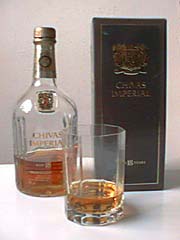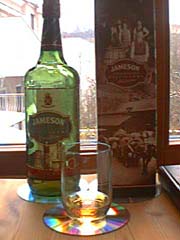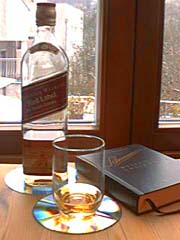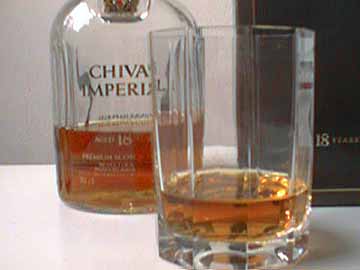
Blended whiskies are composed from many carefully selected components from different distilleries. Besides the malt components (made from malted barley) there are some or many grain whiskies used. Grain whiskies are made from unmalted barley, maize or wheat. These continous-still distilled grains are much less aromatic and distinctive than the pot-still-distilled malt whiskies. Because of the many basic whiskies used, a blend can retain its style and quality very constant over long periods of time, at least some decades, and the blenders go into any effort to ensure their special house style.
It is some twenty years now that I owned and enjoyed this blend on a regular basis.
If I remember right, it is extremely smooth and pleasing, but not really exciting.
Even in my childhood I noticed the B&W advertising with the two dogs. As a student I had sometimes a bottle of this
blended whisky at home, but it never lasted long...
When I shortly retasted a bottle of
Black & White I was a bit disappointed. While it is quite drinkable, it is not
interesting enough for my current requirements...

The older brother of Chivas Regal. 18 years old. Very round, full, smooth, a perfect blend.

The preferred every-day whisky of my wife. 12 years old. Very round, smooth, a perfect blend.
A good blend. It has everything to be expected from a Scotch blend of the 12 year class. But even more interesting is its bottle...

This is the most widely known Irish blend.

My standard whisky. Its Cardhu and Talisker components (besides many others) let this affordable whisky be a rather rich, interesting blend.
This is a blend of at least 12 years aged components.
I myself cannot find the difference to the Red Label significant enough to justify the higher cost, but if someone would give it to me as a gift, I would appreciate it...
This whisky is unusual expensive but still a blend. It costs about twenty times as much as the Red Label! If I had so much money to spend I would rather invest in some more Single Malts... ;-)
A simple, well made blend.
It also has a story.
Once William Sanderson let his friends taste one hundred different casks of blend.
The most appreciation was earned by that vat with number sixty-nine. Such the name for
the blend was found: It was simply called "VAT 69".

|

|
 since Nov 23, 1999.
since Nov 23, 1999.
created Nov 22, 1999
last update Dec 1, 1999
rm of arTm&friends
